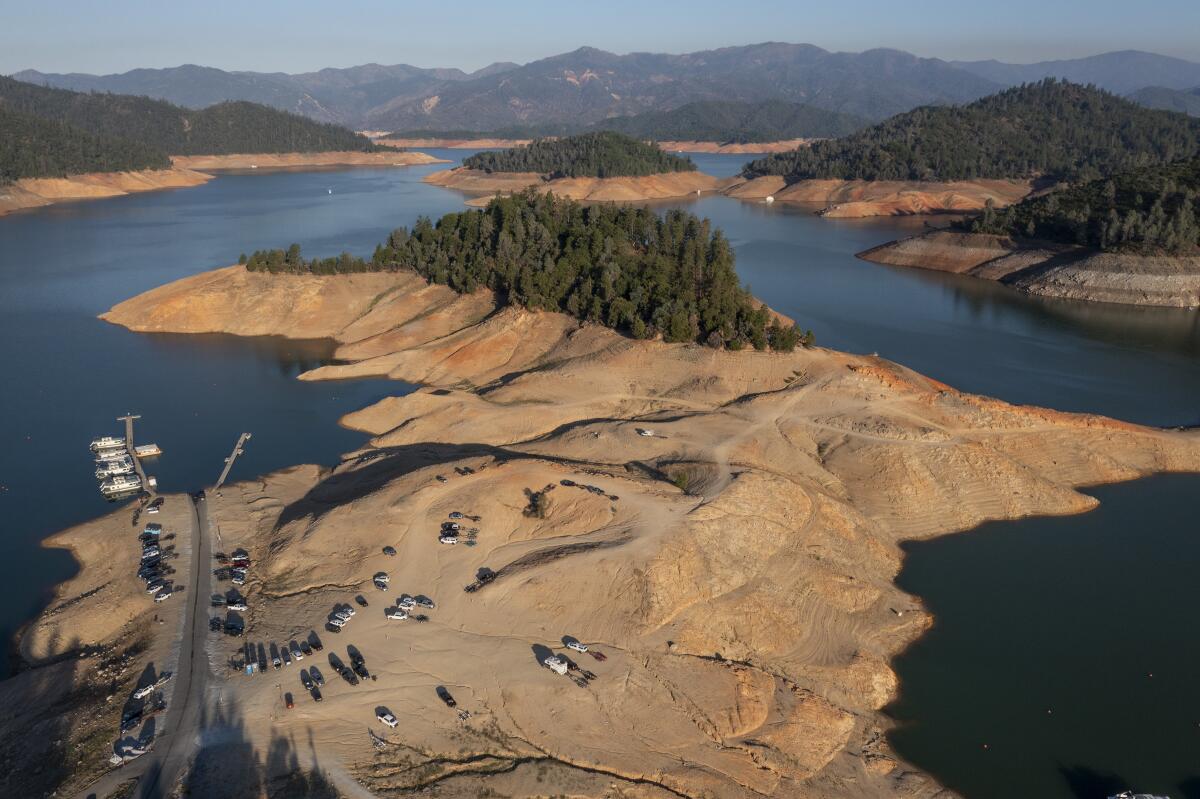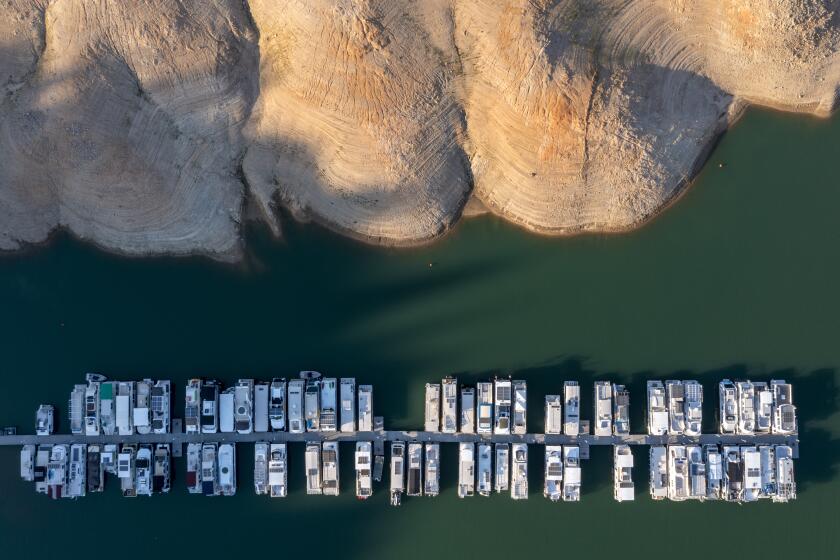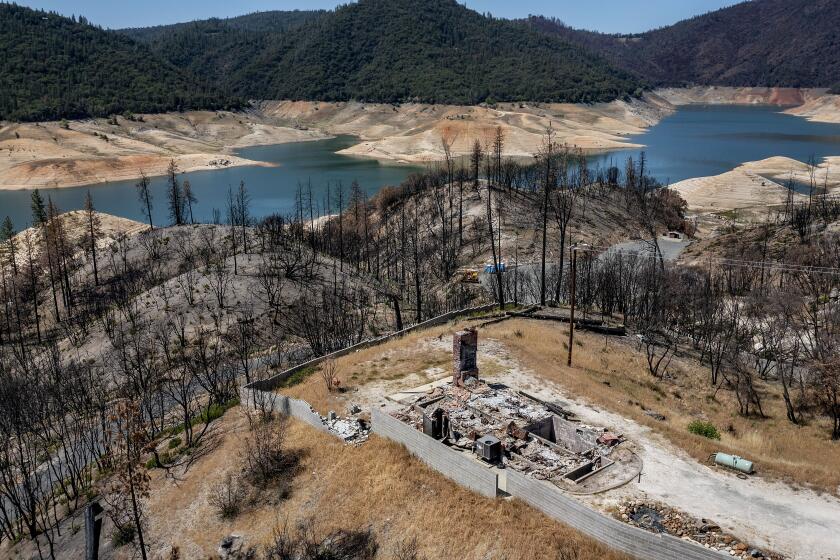Alarmingly low rain levels prime California for fire danger in summer, fall

- Share via
California has recorded alarmingly low levels of rain across the state over the last year, according to measurements completed this week, worsening an already bad drought and priming vegetation for a potential disastrous fire season.
The situation was most critical in Northern California, where rain and snow provide water for other parts of the state.
But Southern California didn’t fare much better.
“Rain years” are measured from the beginning of July to the end of June, and the last 12 months were the seventh driest in Los Angeles’ 144 years of records, said Jan Null, meteorologist and founder of Golden Gate Weather Services.
Null tracks rainfall in California and found that from July 2020 through June 2021, the L.A. received 5.82 inches of rain — 41% of what the city typically records.
Despite that grim distinction, Los Angeles was in bit better position than its neighbors to the north.
L.A.’s rainfall from July 2018 to June 2021 is within 92% of what is considered normal, Null said.
In comparison, the Northern Sierra region recorded its third driest year on record — and its second driest two-year span — according to Golden Gate Weather Services data.
“California can usually weather one dry year without significant impacts,” Null said. “When we start having back-to-back [dry] years, that’s when we run into problems.”
While droughts are common in California, this year’s is much hotter and drier than others, evaporating water more quickly from the reservoirs
“If I have one metric to look at for California water, it is going to be the northern Sierra Nevada,” he continued, “because that’s the watershed that feeds into the Sacramento River, Lake Shasta, Whiskeytown, Lake Oroville, which are the biggest reservoirs.”
California as a whole is in the middle of a second-dry year, with 2020 being the 13th driest in statewide precipitation and the fifth driest in statewide runoff, according to the California Department of Water Resources, which uses an October-to-September “water year” to measure rainfall. In May, Gov. Gavin Newsom declared a drought emergency in 41 of the state’s 58 counties.
“The current water year isn’t over yet. ... But it’s clear, we will be very dry,” said Jeanine Jones, an interstate resources manager at the DWR. “Runoff-wise, I think it will be in the top five driest.”
The National Weather Service, which also uses the October-September water year to measure precipitation, has observed similarly disconcerting numbers for the Los Angeles region.
Since October, downtown L.A. has recorded just 5.82 inches of rain; normal rainfall would measure 14.64 inches over that period, meteorologist David Sweet with the weather service’s Oxnard station said.
“The rainfall since Oct. 1 is only 40% of normal, and that’s the second year in a row that we’ve been significantly below normal,” Sweet said.
Less rain means less water, which is a growing concern across the state.
While some areas of California — including Silicon Valley and wine country — are already imposing water restrictions, Southern California is in better shape because of ample water reserves. But those supplies are limited.
In Silicon Valley, officials are calling for a mandatory 33% reduction in water use compared with 2013 and plan to rely almost entirely on groundwater.
The L.A. County Department of Public Works tracks water supply in a few different ways, including by capturing and measuring rainfall.
In an average year, the department captures about 65 billion gallons of water, director Mark Pestrella said. But since October 2020, only about 14 billion gallons have been captured. That is about 22% of the average annual rainfall that L.A. captures, Pestrella said.
“It’s kind of a one-two-three punch of drought, because there’s no water in the local L.A. area, and the Colorado River was extremely dry, and the northern Sierra Nevada and the southern Cascades were extremely dry,” said Benjamin Hatchett, an assistant research professor at the Desert Research Institute. “It is just incredibly bone dry all across the state.”
And the dry conditions are exacerbating fire risks. “It puts a lot of stress on the vegetation, on the hillside,” Sweet said. “Fire dangers are expected to be high.”
State leaders in climate change and water resources warn that California’s drought is already causing dire conditions for people, plants, animals and land.
As summer progresses, expect conditions to worsen, experts said.
“Once June gloom comes to an end, things are gonna dry out really quick,” Hatchett warned. “Then it’s just a matter of an ignition. ... Fingers crossed we don’t have another lightning outbreak, like what happened last year. That really just was probably one of the worst-case scenarios.”
A trio of fires raging in Northern California this week illustrate the dangers of the dried-out landscape. The Lava fire, which was sparked by lightning Saturday, had swelled to more than 23,000 acres Friday. It has forced the evacuation of several thousand residents, with gusty red flag conditions fueling flames earlier in the week. To the south, the Salt fire ignited Wednesday night and ballooned to 4,500 acres in less than 24 hours.
And fire isn’t the only consequence of drought in California. Jones, with the state Department of Water Resources, said harmful algal blooms are becoming more common, producing dangerous toxins in water.
The dry spells and heat waves occurring across California also point to the worsening effects of climate change.
“Drought and heat often go together. And heat waves over the last two decades have become longer, more frequent, more intense,” retired oceanographer and climatologist William Patzert said.
“Droughts are not unusual in the West, and certainly not in California. But the intensity of this one is worse than what we saw in the ’50s and ’60s,” he said.
“This is not climate change in the future. This is climate change right now.”
More to Read
Sign up for Essential California
The most important California stories and recommendations in your inbox every morning.
You may occasionally receive promotional content from the Los Angeles Times.














